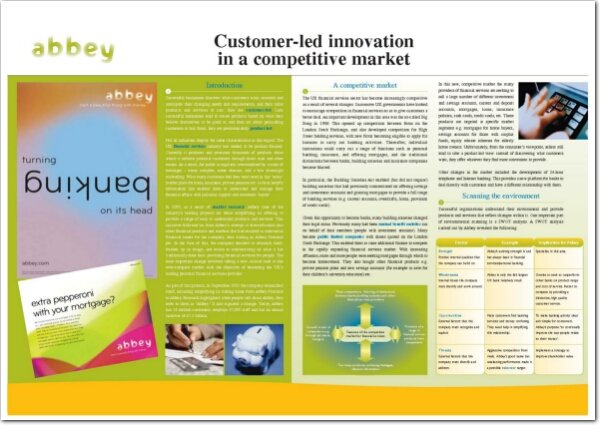Subscribe | Write for Us | Contact | Terms of Service | Privacy Policy | Copyright
© Copyright 1995 - 2023 GC Digital Marketing
Customer-led innovation in a competitive market (PDF)
Customer-led innovation in a competitive market in full in PDF format taken from edition 9 of Business Case Studies.
As a result of carefully reading the Case Study, students should be able to
- explain the difference between a product-led and a customer-led approach to business
- explain the importance of ongoing market research for identifying customer requirements and thereby enabling an organisation to deliver consumer focused benefits
- give examples of ways in which Abbey has simplified its communications with customers.
Read the case study online here
Customer-led innovation in a competitive market in full in PDF format taken from edition 9 of Business Case Studies.
As a result of carefully reading the Case Study, students should be able to
- explain the difference between a product-led and a customer-led approach to business
- explain the importance of ongoing market research for identifying customer requirements and thereby enabling an organisation to deliver consumer focused benefits
- give examples of ways in which Abbey has simplified its communications with customers.
Read the case study online here
Enjoy Unlimited Access To All Our Case Studies
Read the case studies online, download PDF’s and access lesson plans, worksheets and MP3 audio files for each case study with one of our subscriptions.
All of the levels include:
- No advertisements
- Unlimited access
- 600+ case studies to view online
- downloadable worksheets
- downloadable lesson plans
- Audio MP3 case studies
- 600+ PDF case studies to download
- discounted ebooks in our eBook shop
- Early access to new content
Academic User Site License
The academic user license once set up allows easy access for all teachers and students at one academic site with our IP-based login making it easier as there is no requirement to have separate logins and passwords. If you require access to more than one site then a separate license is required for each site, for multiple sites please contact us for pricing.

